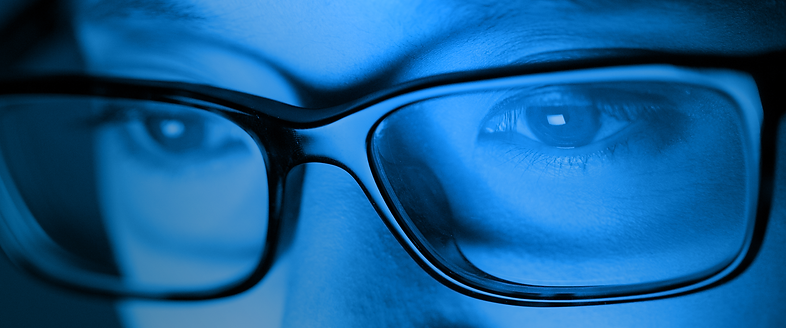
Digital Eye Fatigue
Are you reading this article on a computer, tablet, or worse still, a smartphone? Do you find your eyes getting sore after a while, and feel like having a shut eye after a short duration of reading? You could very well be experiencing a 21st century phenomenon known as Digital Eye Fatigue, commonly also known as Computer Vision Syndrome.

A study had found that nearly 60% of us are looking at digital screens for 5+ hours per day! [2]
Other common symptoms for this condition include:
-
Headaches (especially starting around the eyes, temple or forehead region)
-
Pressure feeling just behind or within the eyes
-
Blurry vision after prolonged reading
-
Burning feeling in eyes
-
Dry or watery eyes
-
Migraines*
-
Neck aches/tight shoulders
-
Difficulty falling asleep at the end of a screen-intensive day

This can happen even if you are under 40 years of age, and is now becoming more common due to the increasingly digital world we live in. A study performed in 2015 reported that two-thirds of New Zealanders own 3 or more digital devices, and more than half of us (59%) prefer using the smaller-screened smartphone over other more vision-friendly devices. [1]
So what causes Digital Eyestrain?
Imagine holding your arms stretched out straight in front of you, for 2-3 hours in a row and a total of 8 hours or more every single day.
It would feel pretty tired wouldn’t it?
A similar effect happens when your eyes have to try and actively focus up close for prolonged periods of time – the eye muscles get fatigued and can ache after a while.
There has also been new evidence finding that small misalignments between the eyes can cause undue strain and cause a variety of the previously mentioned symptoms, altogether which is called trigeminal dysphoria.
This effect can be even more pronounced for the over 40’s, where a normal age-related loss of near focusing ability makes this task even more difficult to perform.
It’s also been shown that when we stare at a computer screen, we actually blink 66% less often! This along with common office environmental factors can also contribute to dry, uncomfortable eyes.
What’s the solution?
To start with, having a comprehensive eye exam to rule out any pre-existing vision conditions is essential to ensure that your eyes have not been working harder than necessary. Conditions such as astigmatism (oval-shaped corneas) and anisometropia (different prescriptions between the eyes) may pile on even more weights on that outstretched hand, if we return back to our earlier analogy!
Simple practical changes such as reducing background glare and taking regular breaks can also help alleviate some of the symptoms.

A simple rule to go by is the 20/20/20 rule: After every 20 minutes, look at something 20 metres away, for at least 20 seconds.
With the recent up tick in digital screen use however, traditional measures can be insufficient to maintain healthy, comfortable eyes.
What are the modern solutions?
It really comes down to the area of weakness within the eyes for each individual. It may be that the focusing muscle isn't quite as effective as it should be, whether it is due to age or it is just simply cramped up and struggling to relax. Or it could be due to slight misalignments of the eyes that is not giving you a comfortable viewing experience.
For most people, the brain is able to put the two images seen from each eye separately together into one clear image.
On the other extreme, some people's eyes are majorly misaligned and the brain is not able to fuse the images together at all. In this case the brain typically shuts off one of the images, this way you don't end up seeing two of everything.
However when there is a minor misalignment of the eye, the brain is still able to fuse the images together, but only with concerted effort. It is this effort that over long periods of time causes strain, which can lead to all the symptoms linked with digital eye fatigue.
In this case, one would require a thorough workup of the visual system to assess for whether the misalignment is present, and what amount of prism needs to be prescribed to bring the two eyes into a comfortable level of alignment.

There are also specific lenses such as anti-fatigue lenses as well as occupational lenses that are typically referred to as "computer glasses". These help the vision by correcting the slight defocus within the eyes (if any), and assist the eyes in focusing closer up, and thereby taking the load off the focusing muscle. These lenses typically come with a blue light filter which helps reduce glare and unwanted reflections, and have been shown to provide general ease to the vision, as well as improve the quality of sleep for those who are on the screens late at night time.

As you can see, there are many little nuances and things to consider when it comes to tired eyes from screen use, all of which contributes to significantly affect your overall well-being throughout the day, and the addressing of which has been shown to significantly increase productivity.
Our optometrists in Westgate Optometrists are especially vigilant with assessing for underlying issues with the visual system, and our longer appointment times allow us to do these further tests.
To resolve your eye fatigue, simply book in with us below.
* your eyes may not be the only cause for these symptoms – our optometrist can certainly advise you on whether your eyes are the likely cause, but it’s generally a good idea to have your health checked by your doctor if you haven’t already done so.
[1] A Report on a Survey of New Zealanders’ Use of Smartphones and other Mobile Communication Devices 2015, Research New Zealand
[2] 2015 Digital Eye Strain Report – The Vision Council

